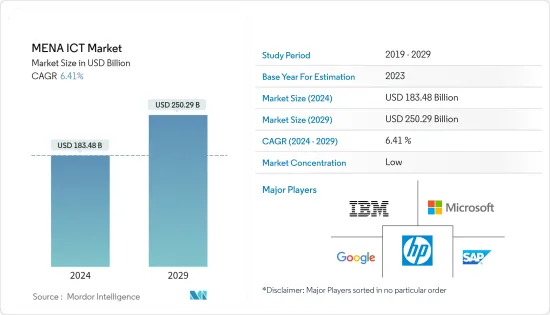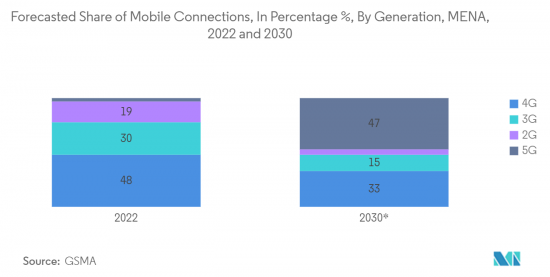PUBLISHER: Mordor Intelligence | PRODUCT CODE: 1408852

PUBLISHER: Mordor Intelligence | PRODUCT CODE: 1408852
MENA ICT - Market Share Analysis, Industry Trends & Statistics, Growth Forecasts 2024 - 2029

The MENA ICT Market size is estimated at USD 183.48 billion in 2024, and is expected to reach USD 250.29 billion by 2029, growing at a CAGR of 6.41% during the forecast period (2024-2029).
The ICT sector in the MENA region has been experiencing significant growth in recent years. Vendors in the industry are choosing strategic alliances, mergers, and acquisitions due to the fast-expanding digital transformation ecosystem to meet the growing need for converting current businesses and keeping a competitive edge over rivals.
Key Highlights
- Businesses across industries are embracing digital transformation to adapt to the new normal and enhance their resilience, driving the demand for ICT solutions that enable automation, data analytics, and e-commerce. Further, the highlighted importance of telehealth led to increased adoption of virtual consultations, remote patient monitoring, and e-health services, providing opportunities for health-tech startups to innovate new solutions.
- Ongoing events and the growing tourism sector are driving the demand for automation. From smart ticketing systems at cultural events to automated services in tourist facilities, the country is embracing technology to enhance efficiency and visitor experiences. Additionally, automation plays a crucial role in managing the increased service demand, ensuring a seamless and modernized approach to hospitality and event management.
- In addition to this, the MENA government has significantly driven digital transformation initiatives. The Oman government has implemented various policies and strategies to encourage the adoption of ICT solutions, including the National Digital Strategy and the Oman Vision 2040. These initiatives focus on enhancing digital infrastructure, promoting e-government services, and fostering innovation.
- Security and privacy concerns are among the key challenges faced by the MENA ICT market. As organizations increasingly rely on digital technologies, they are collecting and storing huge amounts of confidential data, making them vulnerable to data breaches and cyberattacks. Additionally, as the number of connected devices grows, so does the attack surface for hackers, which makes it more difficult to secure these devices and the data they gather and transmit.
- The COVID-19 pandemic had a profound impact on the economies of the MENA region, compounding the digital transformation efforts from the government authorities of various sectors and businesses across various end-user industries, resulting in increased demand for ICT solutions. While the pandemic posed initial challenges, it also presented opportunities for ICT companies in the region to meet the evolving needs of businesses and individuals.
MENA ICT Market Trends
Communication and Connectivity Component to Hold Major Share
- The rapidly growing adoption of smartphones and mobile devices is driving the growth of mobile communication services. Mobile data traffic is projected to reach an all-time high due to the growing popularity of data-intensive apps like video streaming, social networks, and online gaming. According to the study by GSMA, the share of 3G, 4G, and 5G mobile connections is expected to increase rapidly by 2030, with the share of 5G connections rising from 3% in the last year to 47% in the coming years.
- Cloud-based communication tools, such as video conferencing platforms, messaging applications, and collaboration software, have revolutionized the way businesses and individuals communicate. These tools offer the flexibility, scalability, and cost-effectiveness that today's dynamic work environments demand. The increasing adoption of cloud-based communication solutions is driving growth in the cloud computing and Software as a Service (SaaS) segments of the ICT market.
- High-speed internet service has been rolled out by the Communications, Space, and Technology Commission (CST) to 21,000 villages and immigration areas in different parts of Saudi Arabia, providing continuity of communication services to over 5 million people and demonstrating the progress of the Kingdom's communications and technology system.
- According to Ericsson's Mobility Report of 2022, mobile network data traffic in the Middle East has doubled in the last two years, primarily driven by increased smartphone, mobile broadband, and digitalization usage. Further, the technological advancements in AI, Machine Learning, IoT, and Metaverse and their growing use create demand for high-speed connectivity across the countries of the MENA region.
- The Middle East region is witnessing advancements in emerging technologies, such as augmented reality (AR), virtual reality (VR), and metaverse, which are expected to become a part of day-to-day life. Such emerging technology trends are expected to escalate the need for better network connectivity requirements in the coming years and drive the demand for networking-related solutions.

United Arab Emirates to Hold Significant Market Share
- The United Arab Emirates (UAE) is one of the most competitive information and communication technology (ICT) sectors in the MENA region and the key international trading and business hub. Initiatives by the UAE government to create a competitive knowledge economy and internationally integrated business environment to lessen its reliance on oil and gas revenue and expand the private sector are driving the demand for ICT products and services across various industries. The UAE Digital Government Strategy 2025 is accelerating the implementation of digital government services across the country's seven emirates. The growing focus on digital inclusion and increasing the resilience and adaptability of society from the COVID-19 pandemic is propelling market growth.
- The introduction of the Personal Data Protection Law at the start of 2022 refines data security and privacy protocols and applies to companies that process the data of UAE citizens and residents inside or outside of the country. It is projected to create the need for security and compliance-related solutions and services in the country.
- The growing adoption of artificial intelligence (AI) in the country's financial sector is further anticipated to add growth to the market studied. As a result, the country is emphasizing AI technology. For instance, according to the International Trade Administration (ITA) in the United States, AI is anticipated to contribute around 14% of the country's GDP (or USD 96 billion) by 2030. Between 2018 and 2030, AI's contribution to the UAE economy is anticipated to grow by 33.5% annually.
- In August this year, the country's Artificial Intelligence, Digital Economy, and Remote Work Applications Office and Mastercard signed a MoU to increase AI capabilities and its readiness in the country, focusing on combating financial crime, securing the digital ecosystem, and driving inclusive growth in the country.
- The component software and services segment contributes substantially to the UAE's ICT market. This is mainly due to the increasing demand for advanced technological solutions, such as artificial intelligence, cloud computing, and cybersecurity solutions.
- The increasing level of digitalization with government services to enable time and cost saving, increase business efficiency, digital readiness, successful 5G rollout, and position itself at the forefront of 6G innovation are some of the key factors expected to influence the growth of ICT market in the United Arab Emirates over the forecast period.
MENA ICT Industry Overview
The MENA ICT Market is fragmented. The major factors governing this force are sustainable competitive advantage through innovation, levels of market penetration, barriers to exit, power of competitive strategy, and firm concentration ratio. Some of the players include Google LLC (Alphabet Inc.), IBM Corporation, Microsoft Corporation, HP Inc., and SAP SE. The players in the market studied are looking to strengthen their competitiveness through various efforts. Overall, the intensity of competitive rivalry is expected to be high.
- November 2023 - Haboob, a cybersecurity service provider owned by the Saudi Federation for Cybersecurity, Programming, and Drones, declared its partnership with Google Cloud with the aim of providing Chronicle CyberShield to Saudi Arabia. This marks the first time Chronicle CyberShield would be offered in a managed services model in the country, targeting to strengthen cybersecurity services for public sector organizations.
- September 2023 - G42 and Microsoft embarked on the next phase of their ongoing strategic collaboration. They declared a multifaceted plan to make available sovereign cloud offerings, co-innovate and provide advanced AI capabilities, and extend the existing data center infrastructure in the United Arab Emirates. By combining their expertise and existing capabilities, the companies would also focus on bringing advanced, AI-enabled, industry-specific solutions for energy, health, and life sciences, sustainability, and projects of national significance.
Additional Benefits:
- The market estimate (ME) sheet in Excel format
- 3 months of analyst support
TABLE OF CONTENTS
1 INTRODUCTION
- 1.1 Study Assumptions and Market Definition
- 1.2 Scope of the Study
2 RESEARCH METHODOLOGY
3 EXECUTIVE SUMMARY
4 MARKET INSIGHTS
- 4.1 Market Overview
- 4.2 Industry Attractiveness - Porter's Five Forces Analysis
- 4.2.1 Bargaining Power of Suppliers
- 4.2.2 Bargaining Power of Consumers
- 4.2.3 Threat of New Entrants
- 4.2.4 Threat of Substitutes
- 4.2.5 Intensity of Competitive Rivalry
- 4.3 An Assessment of the Impact of COVID-19 on the Industry
- 4.4 Analysis of Key Regulatory Reforms
5 MARKET DYNAMICS
- 5.1 Market Drivers
- 5.1.1 Ongoing Events and Tourism Demanding Automation
- 5.1.2 Government Policies and PPP Initiatives
- 5.1.3 Rising Digital Transformation in the Industries
- 5.2 Market Restraints
- 5.2.1 High Risk of Data Theft
- 5.2.2 Heavy Dependence on Oil and Gas Sector
- 5.3 Key Use Cases
- 5.4 Government Projects and Initiatives
- 5.5 Ecosystem Analysis
6 MARKET SEGMENTATION
- 6.1 By Technology
- 6.1.1 Big Data Analytics
- 6.1.2 Mobility and Telecom
- 6.1.3 Cloud Computing
- 6.1.4 Storage
- 6.1.5 Business Process Outsourcing
- 6.1.6 Other Technologies
- 6.2 By Component
- 6.2.1 Hardware/Devices
- 6.2.2 Software and Services
- 6.2.3 Communication and Connectivity
- 6.3 By End-user Industry
- 6.3.1 Oil, Gas and Utilities
- 6.3.2 Travel and Hospitality
- 6.3.3 Healthcare
- 6.3.4 Financial Services
- 6.3.5 Manufacturing and Construction
- 6.3.6 Other End-user Industries
- 6.4 By Country
- 6.4.1 Saudi Arabia
- 6.4.2 United Arab Emirates
- 6.4.3 Qatar
- 6.4.4 Oman
- 6.4.5 Egypt
- 6.4.6 Rest of MENA
7 COMPETITIVE LANDSCAPE
- 7.1 Company Profiles
- 7.1.1 Google LLC (Alphabet Inc.)
- 7.1.2 IBM Corporation
- 7.1.3 Microsoft Corporation
- 7.1.4 HP Inc.
- 7.1.5 SAP SE
- 7.1.6 ETISALAT (Emirates Telecommunication Group Company PJSC)
- 7.1.7 Oracle Corporation
- 7.1.8 Salesforce Inc.
- 7.1.9 Accenture PLC
- 7.1.10 Amazon Web Services (AWS)
- 7.1.11 Cisco Systems Inc.
- 7.1.12 Huawei Investment & Holding Co. Ltd
8 INVESTMENT ANALYSIS




